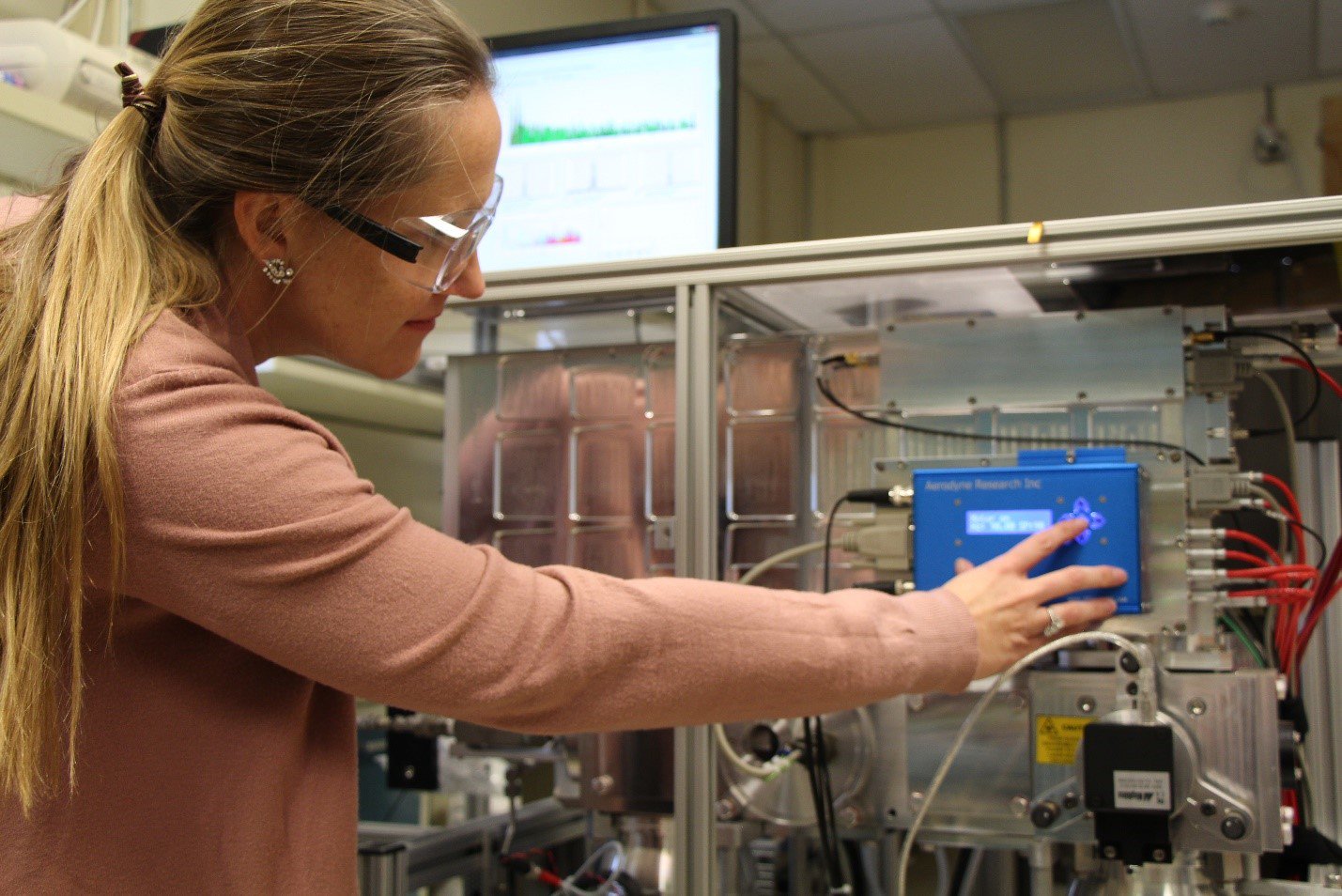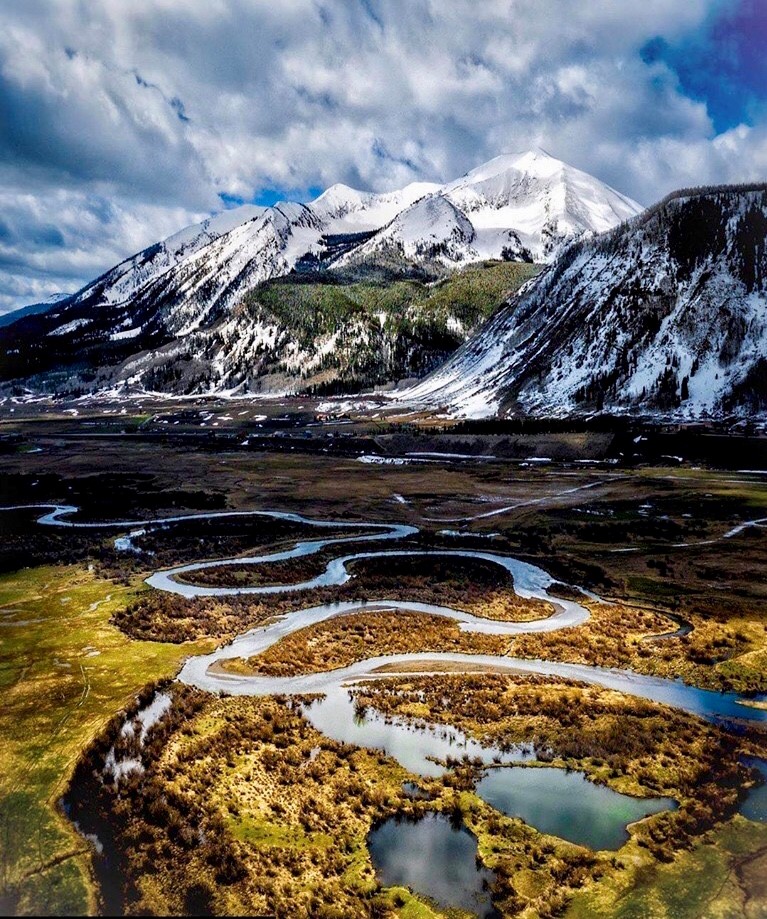UEC Profile: The Aerosol World’s Busy Bee
Published: 23 March 2021
A New Mexico researcher pauses to reflect on her latest absorbing year of research, report writing, and science leadership
Editor’s note: This is the first article in a new series of profiles on members of the ARM User Executive Committee (UEC).

The word “busy” has only four letters, but Allison C. Aiken, an aerosol scientist at Los Alamos National Laboratory in New Mexico, is vigorously occupied with a whole alphabet of tasks.
In January 2021, Aiken took over as chair of the User Executive Committee (UEC), the user liaison group for the U.S. Department of Energy’s Atmospheric Radiation Measurement (ARM) user facility.
“For the first time,” she says, “we want to develop subgroups to lead concentrated efforts on a few key topics.”
Along the way, the UEC will explore better communications with satellite-data communities, high-latitude researchers, and perhaps even budding scientists working at the undergraduate level.
That’s already a lot, but just two months before starting the UEC post, Aiken gave birth to her second daughter, Alexandria. (Older daughter Alisha, meanwhile, is not even 3.)
Whew!
The Roles Roll On
In July 2020, Aiken co-authored an ARM report on the aerosol chemical speciation monitor, an instrument designed to adapt the aerosol mass spectrometer to routine, long-term data gathering.
In August 2020, she was named editor-in-chief of Atmosphere, a peer-reviewed, open-access monthly journal. It devotes space to 10 topical sections, from aerosols and land-atmosphere interactions to the upper atmosphere and planetary atmospheres, which envelop other astronomical bodies in the solar system.
And how about a bit of research?
In 2020 alone, Aiken―whose 50-plus papers have already earned around 10,000 citations―co-authored studies that bring science closer than ever to understanding the ways aerosols grow, evolve, and move through the atmosphere. These ultrafine liquid and solid particles influence cloud formation, precipitation, and surface energy budgets.
During her busy-scholarship year of 2020, Aiken helped write a paper using ARM Eastern North Atlantic measurements to demonstrate a novel method for identifying regional aerosol baseline data.
Burning for Wildfire Insights

Aiken and others are busy studying aerosols that result from wildfires. The energy of such epic blazes can inject aerosols into the atmosphere up to about 12 kilometers (7.4 miles). During high-altitude transport, over sometimes thousands of miles, these aerosols “age”—evolve—into different shapes, and their water content and chemistries also change. The atmosphere―influenced over long distances by shifting conditions of light, moisture, and temperature―becomes a kind of aerosol fun house.
In one 2020 paper Aiken co-authored, researchers tracked plumes of long-range aerosols from record 2017 wildfires in Canada to their descent into marine boundary-layer clouds in the remote eastern North Atlantic. By then, evaporation and bleaching had stripped the aerosols of most of their brown carbon, which is known to absorb light and heat the atmosphere.
This almost complete loss of brown carbon led the authors to speculate that, taken as a global average, such wildfire-created carbon does not have a large warming effect.
They also speculated that the accelerated movement of the transported plumes downward makes North American wildfire aerosols a significant source of cloud-thickening cloud condensation nuclei.
The study—funded by the U.S. Department of Energy’s Atmospheric System Research (ASR)—used data from ARM’s Aerosol and Cloud Experiments in the Eastern North Atlantic (ACE-ENA) field campaign.
“It’s amazing that we have the technology to see these events at the single-particle level with in situ measurements on the ground and aloft,” she says, “and what large impacts they have on chemical processes and interactions with clouds―despite these particles having diameters smaller than the width of a human hair.”
Adding to her body of work, Aiken was the aerosol-chemistry lead on an ASR-funded study of evolving chemical, optical, and other properties in multiple wildfire plumes. An epic 2019 biomass burning event in Arizona made the investigation possible.
SAILing On

The year ahead, and more, also looks very busy for Aiken. She leads a five-scientist aerosol team for ARM’s Surface Atmosphere Integrated Field Laboratory (SAIL) field campaign, slated to begin in September 2021 in mountainous Colorado terrain.
The team will hunt for the region’s dominant seasonal aerosol regimes and will investigate how these regimes redistribute radiative energy. What are the aerosol life cycles like, the team asks, and what is the role of aerosol chemistry?
Dust and wildfire events in the spring and summer will be part of SAIL’s observational mission. One question goes: Do wildfires and summer convective storms increase the number of ice-nucleating particles? In colder months, Aiken’s team will look at the radiative effects of brown-tinged dust on high-altitude snow cover in the research area, Colorado’s East River Watershed.
Aiken calls SAIL “the largest-scale ARM campaign in complex mountain terrain.” SAIL is led by Daniel Feldman, a UEC member from Lawrence Berkeley National Laboratory in California.
Another Colorado-based ARM field campaign, the 2010–2011 Storm Peak Lab Cloud Property Validation Experiment (STORMVEX), laid the foundations for SAIL, though it only covered a single winter and spring. SAIL, on the other hand, is scheduled to be nearly two years long and will allow for deeper looks at more seasonal dependencies than STORMVEX could.
Aiken notes that advances in aerosol measurements and the expansion of ARM Aerosol Observing Systems over the last decade will help propel SAIL. (She helped document that expansion in a December 2019 paper she co-wrote.)
“All this will enable us to better probe the chemical processes of aerosols and their impacts on clouds and precipitation,” says Aiken, using capabilities “that were not available during STORMVEX.”
In addition, she says, SAIL will pair with the Watershed Function Scientific Focus Area (SFA) led by Berkeley Lab. The SFA is funded by the U.S. Department of Energy’s Biological and Environmental Research (BER) program to explore floods, drought, and other disturbances that affect hydrology in mountain systems.
Berkeley Lab’s Kenneth Williams, the SFA’s deputy director, is a SAIL co-investigator.
“It’s a very unique cross-collaboration within BER,” says Aiken, a champion of multidisciplinary aerosol work. “It lets us have one of the biggest, strongest teams to study aerosol processes and how aerosol-cloud interactions affect mountain hydrology.”
Learn more about Aiken and her life, education, and work in this earlier scientist profile on the ARM website.
Read Aiken’s first “From the UEC Chair” message from February 2021.
Keep up with the Atmospheric Observer
Updates on ARM news, events, and opportunities delivered to your inbox
ARM User Profile
ARM welcomes users from all institutions and nations. A free ARM user account is needed to access ARM data.


















